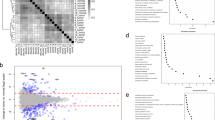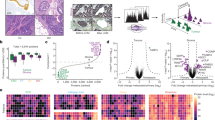Abstract
Molecular crosstalk, including reciprocal stimulation, is theorized to take place between epithelial cancer cells and surrounding non-neoplastic stromal cells. This is the rationale for stromal therapy, which could eliminate support of a cancer by its genetically stable stroma. Epithelial-stromal crosstalk is so far poorly documented in vivo, and cell cultures and animal experiments may not provide accurate models. The current study details stromal-epithelial signalling pathways in 35 human colon cancers, and compares them with matched normal tissues using quantitative proteomic microarrays. Lysates prepared from separately microdissected epithelium and stroma were analysed using antibodies against 61 cell signalling proteins, most of which recognize activated phospho-isoforms. Analyses using unsupervised and supervised statistical methods suggest that cell signalling pathway profiles in stroma and epithelium appear more similar to each other in tumours than in normal colon. This supports the concept that coordinated crosstalk occurs between epithelium and stroma in cancer and suggests epithelial-mesenchymal transition. Furthermore, the data herein suggest that it is driven by cell proliferation pathways and that, specifically, several key molecules within the mitogen-activated protein kinase pathway may play an important role. Given recent findings of epithelial-mesenchymal transition in therapy-resistant tumour epithelium, these findings could have therapeutic implications for colon cancer.
This is a preview of subscription content, access via your institution
Access options
Subscribe to this journal
Receive 50 print issues and online access
$259.00 per year
only $5.18 per issue
Buy this article
- Purchase on Springer Link
- Instant access to full article PDF
Prices may be subject to local taxes which are calculated during checkout



Similar content being viewed by others
References
Araujo RP, Doran C, Liotta LA, Petricoin EF . (2005). Network targeted combination therapy: a new concept in cancer treatment. Drug Discov Today 1: 425–433.
Bergers G, Benjamin LE . (2003). Tumorigenesis and the angiogenic switch. Nat Rev Cancer 3: 401–410.
Bhowmick NA, Neilson EG, Moses HL . (2004). Stromal fibroblasts in cancer initiation and progression. Nature 432: 332–337.
Breiman L . (2001). Random Forests. Machine Learning 45: 5–32.
Brigati C, Noonan DM, Albini A, Benelli R . (2002). Tumor and inflammatory infiltrates: friends or foes? Clin Exp Metastasis 19: 247–258.
Brown PO, Botstein D . (1999). Exploring the new world of the genome with DNA microarrays. Nat Genet 21: 33–37.
Coussens LM, Werb Z . (2002). Inflammation and cancer. Nature 420: 860–867.
Cristofoli G . (2006). New signals from the invasive front. Nature 441: 444–450.
Derycke L, Van Marck V, Depypere H, Bracke M . (2005). Molecular targets of growth, differentiation, tissue integrity, and ectopic cell death in cancer cell. Cancer Biother Radiopharm 20: 579–587.
De Wever O, Mareel M . (2003). Role of tissue stroma in cancer cell invasion. J Pathol 200: 429–447.
Emmert-Buck MR, Bonner RF, Smith PD, Chuaqui RF, Zhuang Z, Goldstein SR et al. (1996). Laser capture microdissection. Science 274: 998–1001.
Fend F, Emmert-Buck MR, Chuaqui R, Cole K, Lee J, Liotta LA et al. (1999). Immuno-LCM: laser capture microdissection of immunostained frozen sections for mRNA analysis. Am J Pathol 154: 61–66.
Gallagher PG, Bao Y, Prorock A, Zigrino P, Nischt R, Politi V et al. (2005). Gene expression profiling reveals cross-talk between melanoma and fibroblasts: implications for host–tumor interactions in metastasis. Cancer Res 65: 4134–4146.
Gulmann C, Sheehan KM, Kay EW, Liotta LA, Petricoin III EF . (2006). Array based proteomics: mapping of protein circuitries for diagnostics, prognostics and therapy guidance. J Pathol 208: 595–606.
Grunert S, Jechlinger M, Beug H . (2003). Diverse cellular and molecular mechanisms contribute to epithelial plasticity and metastasis. Nat Rev Mol Cell 4: 657–665.
Jiang Y, Goldberg ID, Shi YE . (2002). Complex roles of tissue inhibitors of metalloproteinases in cancer. Oncogene 21: 2245–2252.
Joyce JA . (2005). Therapeutic targeting of the tumor microenvironment. Cancer Cell 7: 513–520.
Kopfstein L, Christofori G . (2006). Metastasis: cell-autonomous mechanisms versus contributions by the tumor microenvironment. Cell Mol Life Sci 63: 449–468.
Lambert E, Boudot C, Kadri Z, Soula-Rothhut M, Sowa ML, Mayeux P et al. (2003). Tissue inhibitor of metalloproteinases-1 signalling pathway leading to erythroid cell survival. Biochem J 372: 767–774.
Liotta L, Espina V, Mehta A, Calvert V, Rosenblatt K, Geho D et al. (2003). Protein microarrays: meeting analytical challenges for clinical applications. Cancer Cell 3: 317–325.
Liotta LA, Kohn EC . (2001). The microenvironment of the tumor-host interface. Nature 411: 375–379.
Littlepage LE, Werb Z . (2005). Coevolution of cancer and stromal cellular responses. Cancer Cell 7: 499–500.
Matrisian LM, Cunha GR, Mohla S . (2001). Epithelial-stromal interactions and tumor progression: meeting summary and future directions. Cancer Res 61: 3844–3846.
McCawley LJ, O'Brien P, Hudson LG . (1998). Epidermal grow factor (EGF), and scatter factor/hepatocyte (SF/HGF)-mediated keratinocyte migration is a coincident with induction of matrix metalloproteinase (MMP)-9. J Cell Physiol 176: 255–265.
Mueller MM, Fusenig NE . (2002). Tumor-stroma interactions directing phenotype and progression of epithelial skin tumor cells. Differentiation 70: 486–497.
Nishizuka S, Charboneau L, Young L, Major S, Reinhold WC, Waltham M et al. (2003). Proteomic profiling of the NCI-60 cancer cell lines using new high-density reverse-phase lysate microarrays. Proc Natl Acad Sci USA 100: 14229–14234.
Notterman DA, Alon U, Sierk AJ, Levine AJ . (2001). Transcriptional gene expression profiles of colorectal adenoma, adenocarcinoma, and normal tissue examined by oligonucleotide arrays. Cancer Res 61: 3124–3130.
Orimo A, Weinberg RA . (2006). Stromal fibroblasts in cancer: a novel tumor-promoting cell type. Cell Cycle 5: 1597–1601.[E-pub 2006 Aug 1].
Paweletz CP, Charboneau L, Bichsel VE, Simone NL, Chen T, Gillespie JW et al. (2001). Reverse phase protein microarrays which capture disease progression show activation of pro-survival pathways at the cancer invasion front. Oncogene 20: 1981–1989.
Peinado H, Portillo F, Cano A . (2004). Transcriptional regulation of cadherins during development and carcinogenesis. Int J Dev Biol 48: 365–375.
Sawyers C . (2004). Targeted cancer therapy. Nature 432: 294–297.
Sheehan KM, Calvert VS, Kay EW, Lu Y, Fishman D, Espina V et al. (2005). Use of reverse phase protein microarrays and reference standard development for molecular network analysis of metastatic ovarian carcinoma. Mol Cell Proteomics 4: 346–355.
Sun Y, Sinicrope FA . (2005). Selective inhibitors of MEK1/ERK44/42 and p38 mitogen-activated protein kinases potentiate apoptosis induction by sulindac sulfide in human colon carcinoma cells. Mol Cancer Ther 4: 51–59.
Thiery JP . (2002). Epithelial—mesenchymal transitions in tumor progression. Nat Rev Cancer 2: 442–454.
Thomson EW, Newgreen DF, Tarin D . (2005a). Carcinoma invasion and metastasis: a role for epithelial-mesenchymal transition? Cancer Res 65: 5991–5995.
Thomson S, Buck E, Petti F, Griffin G, Brown E, Ramnarine N et al. (2005b). Epithelial to mesenchymal transition is a determinant of sensitivity of non-small-cell lung carcinoma cell lines and xenografts to epidermal growth factor receptor inhibition. Cancer Res 65: 9455–9462.
Tlsty TD, Hein PW . (2001). Know thy neighbor: stromal cells can contribute oncogenic signals. Curr Opin Genet Dev 11: 54–59.
Tomita T, Iwata K . (1996). Matrix metalloproteinases and tissue inhibitors of metalloproteinases in colonic adenomas-adenocarcinomas. Dis Colon Rectum 39: 1255–1264.
Weinstein JN, Myers TG, O'Connor PM, Friend SH, Fornace Jr AJ, Kohn KW et al. (1997). An information-intensive approach to the molecular pharmacology of cancer. Science 275: 343–349.
Wulfkuhle JD, Aquino JA, Calvert VS, Fishman DA, Coukos G, Liotta LA et al. (2003). Signal pathway profiling of ovarian cancer from human tissue specimens using reverse-phase protein microarrays. Proteomics 3: 2085–2090.
Yang J, Mani SA, Weinberg RA . (2006). Exploring a new twist on tumor metastasis. Cancer Res 66: 4549–4552.
Zhang L, Zhou W, Velculescu VE, Kern SE, Hruban RH, Hamilton SR et al. (1997). Gene expression profiles in normal and cancer cells. Science 276: 1268–1272.
Author information
Authors and Affiliations
Corresponding author
Rights and permissions
About this article
Cite this article
Sheehan, K., Gulmann, C., Eichler, G. et al. Signal pathway profiling of epithelial and stromal compartments of colonic carcinoma reveals epithelial-mesenchymal transition. Oncogene 27, 323–331 (2008). https://doi.org/10.1038/sj.onc.1210647
Received:
Revised:
Accepted:
Published:
Issue Date:
DOI: https://doi.org/10.1038/sj.onc.1210647
Keywords
This article is cited by
-
Stromal TRIM28-associated signaling pathway modulation within the colorectal cancer microenvironment
Journal of Translational Medicine (2018)
-
Response to TNF-α Is Increasing Along with the Progression in Barrett’s Esophagus
Digestive Diseases and Sciences (2017)
-
A cadherin switch underlies malignancy in high-grade gliomas
Oncogene (2015)
-
Bisphenol A modulates colorectal cancer protein profile and promotes the metastasis via induction of epithelial to mesenchymal transitions
Archives of Toxicology (2015)
-
Proteomic profiling of the tumor microenvironment: recent insights and the search for biomarkers
Genome Medicine (2014)



